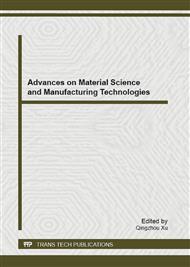[1]
B Deepanjan, T Louis, W T Germinario. Isolation, preparation and characterization of cellulose microfibers obtained from bagasse. Carbohydrate Polymers. 73 (2008) 371-377.
DOI: 10.1016/j.carbpol.2007.12.005
Google Scholar
[2]
D Bondeson, A Mathew, K Oksman. Optimization of the isolation of nanocrystals from mierocrystalline cellulose by acid hydrolysis. Cellulose. 13(2006) 171-180.
DOI: 10.1007/s10570-006-9061-4
Google Scholar
[3]
A Dufresne, J Cavaille, W Helbert. Thermoplastic nanocomposites filled with wheat straw cellulose whiskers: Effect of processing and modeling. Polymer Composites. 18 (1997)198-210.
DOI: 10.1002/pc.10274
Google Scholar
[4]
A Chakraborty, M Sain, Kortsehot M. Cellulose microfibrils: a novel method of preparation using high shear refining and cryoerushing. Holzforsehung. 59(2005)202-207.
DOI: 10.1515/hf.2005.016
Google Scholar
[5]
S Iwamoto, A N Nakagaito, H Yano , M Nogi . Optically transparent composites reinforced with plant fiber-based nanofibers. Appl. Phys.A. 81(2005)1109-1112.
DOI: 10.1007/s00339-005-3316-z
Google Scholar
[6]
H Yano, J Sugiyama, A N Nakagaito, M Nogi, T Matsuura, M Hikita and K Handa. Optically transparent composites reinforced with networks of bacterial nanofibers. Advaneed Materials. 17(2005)153-155.
DOI: 10.1002/adma.200400597
Google Scholar
[7]
Q Cheng, S Wang, T G Rials . Poly(vinyl alcohol )nanocomposites reinforced with cellulose fibrils isolated by high intensity ultrasoication. Composites Part A. 40(2009)218-224.
DOI: 10.1016/j.compositesa.2008.11.009
Google Scholar
[8]
M Seydibeyoglu. , O Krina. Novel nanocomposites based on polyurethane and micro fibrillated cellulose . Composites Science and Technology . 68(2008)908-914.
DOI: 10.1016/j.compscitech.2007.08.008
Google Scholar
[9]
Q Cheng, S Wang. Recent research on nanocomposite reinforced with natural cellulose micro/nanofibril. China Forest Products Industry . 34(2007)3-7.
Google Scholar
[10]
B Wang, S Mohini. Isolation of nanofibers from soybean source and their reinforcing capability on synthetic polymers. Composites Science and Technology. 67(2007)2521-2527.
DOI: 10.1016/j.compscitech.2006.12.015
Google Scholar
[11]
J Y Gu. Adhesive and Coating, China forestry press, Beijing, 1999, pp.63-77.
Google Scholar
[12]
J Li. Wood spectroscopy. Science press, Beijing, 2003, pp.181-185.
Google Scholar
[13]
F A Wyssling. The fine structure of cellulose microfibrils. Science . 119(1954)80-82.
DOI: 10.1126/science.119.3081.80
Google Scholar
[14]
J Araki., M Wada., S Kuga., T Okano. (Birefringent glassy phase of a cellulose microcrystal suspension. Langmuir. 16 (2000)2413–2415.
DOI: 10.1021/la9911180
Google Scholar
[15]
U Weise. Hornification – mechanisms and terminology. Peperi Ja Puu-Paper and Timber. 80 (1998) 110-115.
Google Scholar
[16]
H Noriko, K Tetsuo, I Mitsuro. Enzymatically produced nano-ordered short elements containing cellulose Iβ crystalline domains. Carbohydrate Polymers. 61(2005)191–197.
DOI: 10.1016/j.carbpol.2005.04.018
Google Scholar
[17]
Q Cheng, S Wang . Physical and mechanical properties of polyvinyl alcohol and polypropylene composite materials reinforced with fibril aggregates isolated from regenerated cellulose fibers. Cellulose. 14(2007)593-602.
DOI: 10.1007/s10570-007-9141-0
Google Scholar


